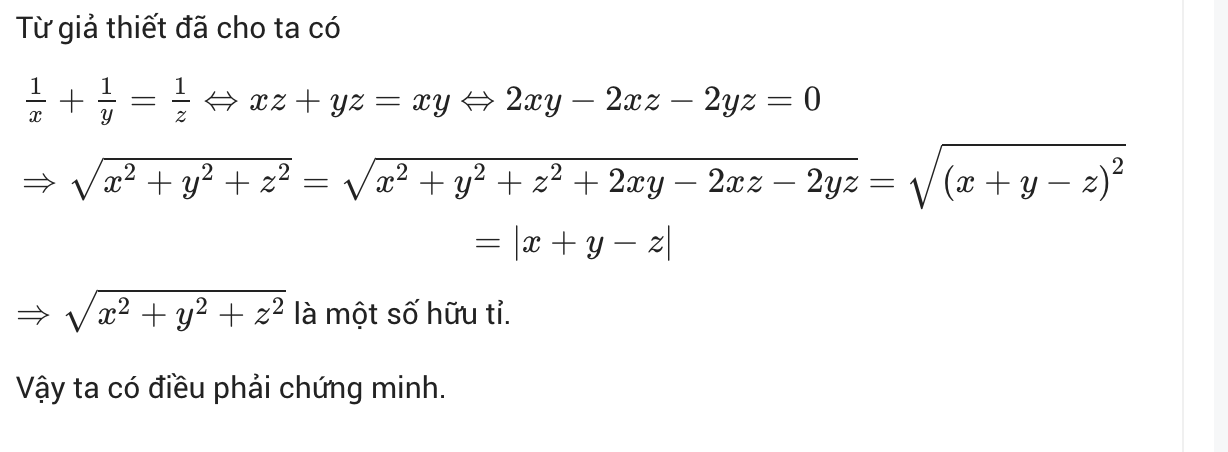Tìm số hữu tỉ x thỏa mãn: \(\dfrac{x+4}{20}+\dfrac{x+3}{21}=\dfrac{x+2}{22}+\dfrac{x+1}{21}\)
Hãy nhập câu hỏi của bạn vào đây, nếu là tài khoản VIP, bạn sẽ được ưu tiên trả lời.


Bài 1:
Ta có: \(3x=2y\)
nên \(\dfrac{x}{2}=\dfrac{y}{3}\)
mà x+y=-15
nên Áp dụng tính chất của dãy tỉ số bằng nhau, ta được:
\(\dfrac{x}{2}=\dfrac{y}{3}=\dfrac{x+y}{2+3}=\dfrac{-15}{5}=-3\)
Do đó:
\(\left\{{}\begin{matrix}\dfrac{x}{2}=-3\\\dfrac{y}{3}=-3\end{matrix}\right.\Leftrightarrow\left\{{}\begin{matrix}x=-6\\y=-9\end{matrix}\right.\)
Vậy: (x,y)=(-6;-9)
Bài 2:
a) Ta có: \(\dfrac{x}{4}=\dfrac{y}{3}=\dfrac{z}{5}\)
mà x+y-z=20
nên Áp dụng tính chất của dãy tỉ số bằng nhau, ta được:
\(\dfrac{x}{4}=\dfrac{y}{3}=\dfrac{z}{5}=\dfrac{x+y-z}{4+3-5}=\dfrac{20}{2}=10\)
Do đó:
\(\left\{{}\begin{matrix}\dfrac{x}{4}=10\\\dfrac{y}{3}=10\\\dfrac{z}{5}=10\end{matrix}\right.\Leftrightarrow\left\{{}\begin{matrix}x=40\\y=30\\z=50\end{matrix}\right.\)
Vậy: (x,y,z)=(40;30;50)

`đk:x ne +-3,x ne -2`
`B=(21/(x^2-9)-(x-4)/(3-x)-(x-1)/(3+x)):(1-1/(x+3))`
`=(21/(x^2-9)+(x-4)/(x-3)-(x-1)/(x+3)):((x+3-1)/(x+3))`
`=((21+x^2-x-12-x^2+4x-3)/((x-3)(x+3))):(x+2)/(x+3)`
`=(3x+6)/((x-3)(x+3))*(x+3)/(x+2)`
`=(3x+6)/((x-3)(x+2))`
`=3/(x-3)`
`b)|2x+1|=5`
`<=>` \(\left[ \begin{array}{l}2x=4\\2x=-6\end{array} \right.\)
`<=>` \(\left[ \begin{array}{l}x=2(tm)\\x=-3(l)\end{array} \right.\)
`=>B=3/(2-3)=-3`
`c)B=-3/5`
`<=>3/(x-3)=3/(-5)`
`<=>x-3=-5`
`<=>x=-2(l)`
`d)B<0`
`<=>3/(x-3)<0`
Mà `3>0`
`=>x-3<0<=>x<3`
a) đk: \(x\ne\pm3\)
\(B=\left[\dfrac{21}{\left(x-3\right)\left(x+3\right)}+\dfrac{x-4}{x-3}-\dfrac{x-1}{x+3}\right]:\left(\dfrac{x+3-1}{x+3}\right)\)
= \(\left[\dfrac{21+\left(x-4\right)\left(x+3\right)-\left(x-1\right)\left(x-3\right)}{\left(x-3\right)\left(x+3\right)}\right]:\dfrac{x+2}{x+3}\)
= \(\dfrac{21+x^2-x-12-x^2+4x-3}{\left(x-3\right)\left(x+3\right)}.\dfrac{x+3}{x+2}\)
= \(\dfrac{3x+6}{\left(x-3\right)\left(x+3\right)}.\dfrac{x+3}{x+2}=\dfrac{3}{x-3}\)
b) Để \(\left|2x+1\right|=5\)
<=> \(\left[{}\begin{matrix}2x+1=5< =>x=2\left(c\right)\\2x+1=-5< =>x=-3\left(l\right)\end{matrix}\right.\)
Thay x = 2, ta có;
B = \(\dfrac{3}{2-3}=-3\)
c) Để B = \(\dfrac{-3}{5}\)
<=> \(\dfrac{3}{x-3}=\dfrac{-3}{5}\)
<=> x - 3 = -5
<=> x = -2
d) Để B < 0
<=> \(\dfrac{3}{x-3}< 0\)
<=> x - 3 < 0
<=> x < 3

a, \(\left(\dfrac{7}{2}-2x\right).\dfrac{10}{3}=\dfrac{22}{3}\Leftrightarrow\dfrac{7}{2}-2x=\dfrac{22}{10}=\dfrac{11}{5}\)
\(\Leftrightarrow2x=\dfrac{13}{10}\Leftrightarrow x=\dfrac{13}{20}\)
b, \(\dfrac{4x}{9}=\dfrac{9}{8}-\dfrac{125}{1000}=1\Leftrightarrow x=\dfrac{9}{4}\)
c, \(-\dfrac{x}{21}=\dfrac{60}{21}\Rightarrow x=-60\)

`@` `\text {Ans}`
`\downarrow`
\(\dfrac{x-3}{3}=\dfrac{2x+1}{5}\)
`=> (x-3)5 = (2x+1)3`
`=> 5x-15 = 6x+3`
`=> 5x-6x = 15+3`
`=> -x=18`
`=> x=-18`
\(\dfrac{x+1}{22}=\dfrac{6}{x}\)
`=> (x+1)x = 22*6`
`=> (x+1)x = 132`
`=> x^2 + x = 132`
`=> x^2+x-132=0`
`=> (x-11)(x+12)=0`
`=>`\(\left[{}\begin{matrix}x-11=0\\x+12=0\end{matrix}\right.\)
`=>`\(\left[{}\begin{matrix}x=11\\x=-12\end{matrix}\right.\)
\(\dfrac{2x-1}{2}=\dfrac{5}{x}\)
`=> (2x-1)x = 2*5`
`=> 2x^2 - x =10`
`=> 2x^2 - x - 10 =0`
`=> 2x^2 + 4x - 5x - 10 =0`
`=> (2x^2 + 4x) - (5x+10)=0`
`=> 2x(x+2) - 5(x+2)=0`
`=> (2x-5)(x+2)=0`
`=>`\(\left[{}\begin{matrix}2x-5=0\\x+2=0\end{matrix}\right.\)
`=>`\(\left[{}\begin{matrix}2x=5\\x=-2\end{matrix}\right.\)
`=>`\(\left[{}\begin{matrix}x=\dfrac{5}{2}\\x=-2\end{matrix}\right.\)
\(\dfrac{2x-1}{21}=\dfrac{3}{2x+1}\)
`=> (2x-1)(2x+1)=21*3`
`=> 4x^2 + 2x - 2x - 1 = 63`
`=> 4x^2 - 1=63`
`=> 4x^2 - 1 - 63=0`
`=> 4x^2 - 64 = 0`
`=> 4(x^2 - 16)=0`
`=> 4(x^2 + 4x - 4x - 16)=0`
`=> 4[(x^2+4x)-(4x+16)]=0`
`=> 4[x(x+4)-4(x+4)]=0`
`=> 4(x-4)(x+4)=0`
`=>`\(\left[{}\begin{matrix}x-4=0\\x+4=0\end{matrix}\right.\)
`=>`\(\left[{}\begin{matrix}x=4\\x=-4\end{matrix}\right.\)
\(\dfrac{2x+1}{9}=\dfrac{5}{x+1}\)
`=> (2x+1)(x+1) = 9*5`
`=> (2x+1)(x+1)=45`
`=> 2x^2 + 2x + x + 1 = 45`
`=> 2x^2 + 3x + 1 =45`
`=> 2x^2 + 3x + 1 - 45 =0`
`=> 2x^2+3x-44=0`
`=> 2x^2 + 11x - 8x - 44=0`
`=> (2x^2 +11x) - (8x+44)=0`
`=> x(2x+11) - 4(2x+11)=0`
`=> (x-4)(2x+11)=0`
`=>`\(\left[{}\begin{matrix}x-4=0\\2x+11=0\end{matrix}\right.\)
`=>`\(\left[{}\begin{matrix}x=4\\2x=-11\end{matrix}\right.\)
`=>`\(\left[{}\begin{matrix}x=4\\x=-\dfrac{11}{2}\end{matrix}\right.\)
\(\dfrac{x-3}{3}=\dfrac{2x+1}{5}\\ \left(x-3\right)\cdot5=\left(2x+1\right)\cdot3\\ x5-15=6x+3\\ x5-6x=3+15\\ -x=18\\ \Rightarrow x=-18\)
\(\dfrac{x+1}{22}=\dfrac{6}{x}\\ \left(x+1\right)\cdot x=6\cdot22\\ \left(x+1\right)\cdot x=2\cdot3\cdot2\cdot11\\ \left(x+1\right)\cdot x=12\cdot11\\ \Rightarrow x=11\)
\(\dfrac{2x-1}{21}=\dfrac{3}{2x+1}\\ \left(2x-1\right)\cdot\left(2x+1\right)=21\cdot3\\ \left(2x-1\right)\cdot\left(2x+1\right)=7\cdot3\cdot3\\ \left(2x-1\right)\cdot\left(2x+1\right)=7\cdot9\\ \Rightarrow2x+1=9\\ 2x=8\\ x=4\)

\(T=21x+3y+\dfrac{21}{y}+\dfrac{3}{x}\)
\(T=\dfrac{x}{3}+\dfrac{3}{x}+\dfrac{7y}{3}+\dfrac{21}{y}+\dfrac{62}{3}x+\dfrac{2}{3}y\)
\(T\ge2\sqrt{\dfrac{3x}{3x}}+2\sqrt{\dfrac{147y}{3y}}+\dfrac{62}{3}.3+\dfrac{2}{3}.3=80\)
\(T_{min}=80\) khi \(x=y=3\)
